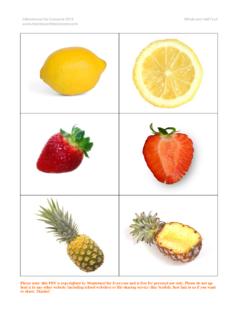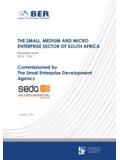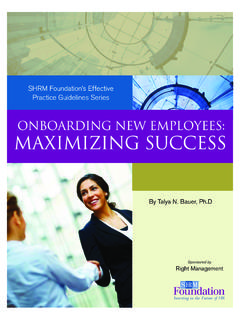Transcription of Building the Better Half VW Engine (-mostly-)
1 Building the Better half VW Engine (-mostly-) A report by Christopher KlemanDisclaimer: This document is for informational purpose only and is not intended to be a guide or definitive how-to for how you decide to build your Engine . This is merely a report of the method and route I chose to follow, and the issues that arose from such a build. You are responsible for your own Engine and you make the final decisions for your own project. Engine Overview:Bore: 94mmStroke: 82mmDisplacement: 1138 CCCompression Ratio: :1 Carburetion: Dual Mikuni VM-32 round slide carburetorsEst. HP: TBDW eight: and Engine crank related case Cylinder Selection and and Learned to pass SourcesWhy the larger displacement?First off I must admit that had I followed a more conventional build with stock 69mm stroke and 92mm cylinders, I would have encountered many fewer hassles along the way. So why did I choose to go the route I did? The first reason: The eventual plan is to fly the Legal Eagle from a backyard strip tucked along the side of the back 40 acres of our farm.
2 While the location will provide a strip long enough to safely fly with a conventional Engine , I wanted a little extra for those hot muggy summer days. The second reason: I like engines, I like to tinker and I was up for a challenge. The third reason: Because I can! And that's what makes home- Building greatCrankshaftSelection and cutting: In order to gain a little power from cutting the Engine in half I chose to go with an 82mm stroker crank. I purchased an EMPI 82mm counter-weighted crankshaft to use as the basis of my build. Doing some research after purchasing the crankshaft I found that counter-weighted didn't mean close to balanced when cut in half and in fact required a rather different route from the standard Better - half VW plans. To use a counter-weighted crankshaft, you must leave the first throw aft of the center bearing on the crankshaft just cut the rod journal off. I accomplished this with a chop saw and some patience. You don't want to overheat the crankshaft so I cut a little bit at a time and let it cool.
3 The hardest part is getting it clamped into the chop saw securely. I left approximately 1/16 to 1/8 of rod bearing material on the crank throw and after being chopped in half ground it down flat with the back of the crank throw. Drill and tap the oil gallery in the back of the crank for an allen head set screw and seal into the back of the crank with sealant. I used Permatex H3 sealant as is recommended for sealing the block issue with leaving the crank throw on the end of the middle bearing is that it means you can no longer place the thrust bearing on the back of the crankshaft as per the Better half plans. Instead you must use the standard split bearing shells in the stock location and move the thrust bearing to the front of the crankshaft (2nd bearing from the prop hub, VW bearing #3 location). The setup used is 1 thrust washer against the crank throw, followed by the thrust bearing, then 2 thrust washers followed by the camshaft drive gear. Unfortunately this doesn't just slide together!
4 The first modification was to increase the inner diameter of the 1st thrust washer so it would slide over the bearing journal. This was done by lightly clamping it in the lathe jaw and sanding away the inner diameter with a Dremel tool and small sanding drum while spinning in the lathe. I did it that way to maintain concentricity as best as possible. You will have to increase this thrust bearings ID slightly larger than the bearing journal diameter because if you look closely at the crankshaft, the transition from the journal to the rod throw is filleted and you don't want the thrust washer standing on the next step was bearing fitment into the case. When I purchased the VW crankshaft bearings I purchased them to fit the stock crank bearing size, the oversize OD to match my case line-bore and I also ordered them with an oversize thrust bearing (as if the case were face cut for the thrust bearing). This gave me the ability to size the bearing for a direct fit onto the case bearing journal.
5 To protect the bearing surface I wrapped the jaws with electrical tape and then LIGHTLY clamped the bearing to cut it. The material is of course soft being a bearing so it machined off very easily with light cuts. I went for a snug fit that didn't require any tapping or hammering to install but wasn't loose either just the front face of the thrust bearing will extend past the bearing journal on the crank, plus we need 2 more thrust washers on top of the thrust bearing. To get everything to fit as needed I needed to back-cut the crankshaft cam timing gear so it would sit against the crankshaft bearing journal as originally intended, but also so it centered and provided room for the 2 thrust washers. You can get very close by measuring the distance from the top of the thrust washers to the face of the crankshaft bearing journal with the end of a caliper. Don't forget you need your oil clearance to be added to this measurement. Measure twice, cut once (I prefer to cut just shy of what is needed so I can test fit and remeasure to sneak up on where it's just perfect).
6 It takes a bit of on and off of the gear, bearing and thrust washer so you'll want a good puller to get everything off without damaging anything. I used a bearing puller though they do make a specific VW tool for pulling the gears. Once you get everything to assemble up to the snap ring and have your appropriate oil clearance by the thrust washers you're set to go. Now take it all apart yet again so you can get the bearings and thrust washers off for balancing! But don't forget to reassemble it with the cam gear, timing gear, gear spacer, snap ring, oil-slinger and prop : This is a job I figured would have been the easy part show up at an Engine shop with the crank and some money and come back a few days later to pick up a balanced crankshaft. The problem I ran into however was that the crankshaft was too small to fit on any of the balancing machines I could find. The machines were designed to spin the crank while being supported at the nose and tail ends of the crankshaft.
7 With the crankshaft cut in half and having a remaining rod throw on the back, (Or in the case of a conventional crank cut in half with the bearing thrust plate bolted on the back) the crank wouldn't clear the balancing support bars that the crank spun on. Fortunately one of the local Engine shops was willing to work with me and gave me a design to build that would bolt onto their machine that could spin the crankshaft. In order to balance the crank we were able to grind a good amount of material away from one side of the back rod throw, and we had to bolt on a weight at the prop hub for some extra weight at the nose. As instructed I started out with a 2 x3 x1/4 steel weight 180* from the key-way in the crank and that turned out to be a great starting point. Since this weight has to be bolted onto the hub, I made sure I bolted a bolt/washers/nut to each prop bolt location and made the bolt 180* from the key-way an extra 1/4 longer than the rest to account for the extra thickness of the CaseProcurement: Surprisingly, finding a used VW Engine in my area was much more difficult than I had expected.
8 Using Craigslist I searched out quite a few engines. Either they were running engines and were going for around $1, or more commonly, they were for sale but I had a nightmare of a time actually getting a response from the seller. In one instance I had to contact the seller 3 times before getting a reply that the Engine was still for sale. He promised to get me more information about the Engine but never did. I spent nearly 2 weeks on that lead alone. Frustrated with trying to deal locally, I turned to e-bay. Running engines tended to bring a fairly good price. Engine cases enough in their own right. However I managed across a case that was the perfect thing. It had spun the flywheel bearing (stock thrust bearing location, VW refers to it as bearing #1). The photos looked bad enough that it was likely out of the realm of repair without welding. I managed to win the case for 70 bucks and with another 30 to ship it I had finally gotten a start on the : I followed the standard block modifications as far as blocking off oil passages and block off plates so I won't go into detail about those.
9 What I did have to modify extra was grinding clearance into the case for the stroker crankshaft and connecting rods. This turned into a small nightmare in it's own right. I used an 82mm stroker crankshaft with stock VW connecting rod journal size. My Pistons and connecting rods were match balanced for crankshaft balancing and I also didn't want to remove any more material from the rods/caps being that they're some of the highest stressed parts inside an Engine . Besides, there's tons of 82mm stroke VW engines driving on the road daily as it's a common modification. Unfortunately I came to find that one of the spots on my block had a rather thin wall in the casting on top and turned paper thin when grinding the required clearance into the case. This isn't a major setback if you have a TIG welder (which I happen to) except that the case is a Magnesium/Aluminum mix. The first step was finding the AZ61 filler rod. The local welding supply could only get me 5lbs at the cost of an arm and a leg.
10 I finally found an online supplier that could sell me 1lb at a reasonable 60 dollars! A good cleaning of the case (Do NOT use brake cleaner!) and off and running with the TIG to build a new high roof wall to solve the problem. (This was only an issue in one side of the case on only one of the rod throws likely a minor casting flaw?) Aside from clearancing the top of the case you also need to clearance around the cylinder opening. To get the proper clearance you will need to temporarily install a cylinder and piston (without the rings) so you can ensure the proper rod motion and geometry inside the Engine . Be careful when installing your cylinder studs as they can protrude through the case savers and inside the Engine case and become an interference issue with the crankshaft. Be certain to check this on final assembly before installing the cylinders. Grinding the necessary clearance into the block wasn't a hard job, just time consuming. If I hadn't the unfortunate luck to find a thin case wall I would have had both case halves clearanced in only 2-3 Fitment: The 94mm cylinders require machining of the case to fit them.







